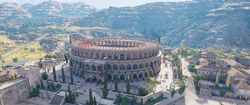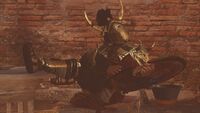mNo edit summary |
(→Trivia) |
||
| Line 16: | Line 16: | ||
==Trivia== |
==Trivia== |
||
| + | *The arena appears to be visually based on the {{wiki|Amphitheatre of El Jem}} or more likely its reconstruction by Jean-Claude Golvin considering that he consulted the development team of ''Origins''.<ref name="golvin">[https://jeanclaudegolvin.com/en/project/north-africa/ Jean-Claude Golvin]. ''North Africa''. jeanclaudegolvin.com. Accessed 28 April 2020.</ref> Locationwise the arena appears to stand in for a Roman theater built in the market of the city.<ref name="Theater 2">[https://www.temehu.com/Cities_sites/cyrene-cyrenaica.htm Temehu]. ''A Map of The Archaeological Sites of Cyrene''. temehu.com. Accessed 28 April 2020.</ref> However, the El Jem architecture of the arena is anachronistic and the market theater was also probably built later than the game's period. Instead, during this time the [[Theater of Cyrene]] was utilized by the Romans and was expanded in the 2nd century CE to serve as arena.<ref name="Arena trivia">[https://www.triphistoric.com/historic-sites/cyrene ''Cyrene, Shahhat, Jabal al Akhdar, Libya'']. ''www.triphistoric.com''. Accessed 21 September 2018</ref><ref name="2nd century CE">[https://pleiades.stoa.org/places/534059885 Pleiades]. ''Theater of Cyrene''. pleiades.stoa.org. Accessed 28 April 2020.</ref><ref name="Theatre-Amphitheatre">[http://ghn.globalheritagefund.org/uploads/library/doc_443.pdf The Theatre-Amphitheatre of the sanctuary of Apollo at Cyrene]. ghn.globalheritagefund.org. Accessed 28 April 2020.</ref> |
||
| − | *The arena is fictional as there was no Roman built dedicated gladiatorial arena in Cyrene in reality. Instead, the [[Theater of Cyrene]] was utilized by the Romans.<ref name="Arena trivia">[https://www.triphistoric.com/historic-sites/cyrene ''Cyrene, Shahhat, Jabal al Akhdar, Libya'']. ''www.triphistoric.com''. Accessed 21 September 2018</ref> |
||
*There are Persian columns and Lamassu statues present in the arena.<ref name="Persian trivia">[https://www.artstation.com/artwork/yrXmJ ''Assassin's Creed Origins - Cyrene Arena Work'']. ''www.artstation.com''. Accessed 14 May 2019</ref><ref name="Persian trivia 2">[https://www.reddit.com/r/assassinscreed/comments/9ajcp8/persian_assets_in_origins_and_odyssey/ ''Persian Assets in Origins and Odyssey'']. ''www.reddit.com''. Accessed 14 May 2019</ref> |
*There are Persian columns and Lamassu statues present in the arena.<ref name="Persian trivia">[https://www.artstation.com/artwork/yrXmJ ''Assassin's Creed Origins - Cyrene Arena Work'']. ''www.artstation.com''. Accessed 14 May 2019</ref><ref name="Persian trivia 2">[https://www.reddit.com/r/assassinscreed/comments/9ajcp8/persian_assets_in_origins_and_odyssey/ ''Persian Assets in Origins and Odyssey'']. ''www.reddit.com''. Accessed 14 May 2019</ref> |
||
Revision as of 00:23, 28 April 2020

View of the Cyrene arena
The Cyrene Gladiator Arena was a gladiator arena located in Cyrene. As one of the gladiator arenas located in Kyrenaika, it was popular among the citizens of Cyrene and the province.
History
The Roman general, Julius Caesar, challenged the arena at some point, clashing against Polymestor, a Thracian gladiator. Caesar defeated the gladiator, eventually sparing him and gave him a sword to signify his freedom.[1]
Sometime later, the Medjay, Bayek challenged the arena in 47 BCE, having being directed by Felix Martialis, the owner of the arena in Krokodilopolis.[2] Bayek clashed with opponents from various parts of Europe, namely The Hammer from Britannia, The Axes from Germania, The Hoplite and The Seleucid, both from Greece and The Duelist from China, defeating them with a variety of weapons.[1]
Shortly after, Bayek returned to take part in the arena, this time facing hordes of fighters, as part of a deal with Thanasis to free Kosey from his employment. Upon finishing his battle, Bayek left the arena, only to find out that Thanasis had betrayed his part of the deal and left to find Kosey.[3]
Rewards
- Priest of Ma'at: defeat The Hammer
- Freeman Sword: defeat The Hoplite
- Roman Legionary outfit: defeat The Duelist
Trivia
- The arena appears to be visually based on the Amphitheatre of El Jem or more likely its reconstruction by Jean-Claude Golvin considering that he consulted the development team of Origins.[4] Locationwise the arena appears to stand in for a Roman theater built in the market of the city.[5] However, the El Jem architecture of the arena is anachronistic and the market theater was also probably built later than the game's period. Instead, during this time the Theater of Cyrene was utilized by the Romans and was expanded in the 2nd century CE to serve as arena.[6][7][8]
- There are Persian columns and Lamassu statues present in the arena.[9][10]
Gallery
Appearances
References
- ↑ 1.0 1.1 Assassin's Creed: Origins
- ↑ Assassin's Creed: Origins – The Lure of Glory
- ↑ Assassin's Creed: Origins – Here Comes a New Challenger
- ↑ Jean-Claude Golvin. North Africa. jeanclaudegolvin.com. Accessed 28 April 2020.
- ↑ Temehu. A Map of The Archaeological Sites of Cyrene. temehu.com. Accessed 28 April 2020.
- ↑ Cyrene, Shahhat, Jabal al Akhdar, Libya. www.triphistoric.com. Accessed 21 September 2018
- ↑ Pleiades. Theater of Cyrene. pleiades.stoa.org. Accessed 28 April 2020.
- ↑ The Theatre-Amphitheatre of the sanctuary of Apollo at Cyrene. ghn.globalheritagefund.org. Accessed 28 April 2020.
- ↑ Assassin's Creed Origins - Cyrene Arena Work. www.artstation.com. Accessed 14 May 2019
- ↑ Persian Assets in Origins and Odyssey. www.reddit.com. Accessed 14 May 2019





